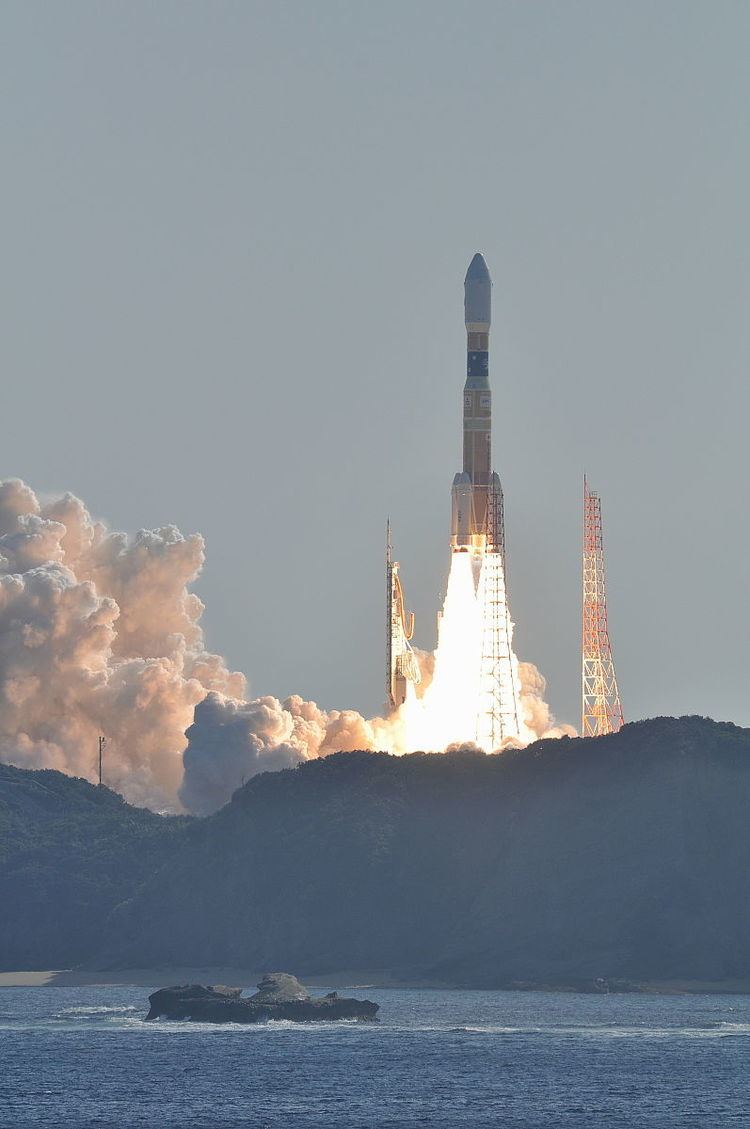Function Launch vehicle Height 56.6 m (186 ft) | Country of origin Japan Diameter 5.2 m (17 ft) | |
 | ||
Mass 531,000 kg (1,171,000 lb) | ||
H-IIB (H2B) is an expendable launch system used to launch H-II Transfer Vehicles (HTV, or Kounotori) towards the International Space Station. H-IIB rockets are liquid-fuelled with solid-fuel strap-on boosters and are launched from the Tanegashima Space Center in Japan. Mitsubishi and JAXA have been primarily responsible for design, manufacture, and operation of H-IIB. H-IIB made its first flight in 2009, and has made a total of five flights through 2015.
Contents
H-IIB is able to carry a payload of up to 8,000 kilograms (18,000 lb) to GTO, compared with the payload of 4,000-6,000 kg for the H-IIA, a predecessor design. Its performance to LEO is sufficient for the 16,500 kg (36,400 lb) HTV. The first H-IIB was launched in September 2009.
Development
The H-IIB launch vehicle is a launch vehicle developed jointly by JAXA and Mitsubishi Heavy Industries to launch the H-II Transfer Vehicle. The H-IIB was designed to adopt methods and components that have already been verified by flights on the H-IIA, so that manufacturing the new launch vehicle would be more cost-effective, with less risk, in a shorter period of time. JAXA was in charge of preliminary design, readiness of the ground facility, and the development of new technologies for the H-IIB, in which the private sector has limited competencies, while the Mitsubishi Heavy Industries is responsible for manufacturing. JAXA successfully conducted eight firing tests of the new cluster design with the simulated first-stage propulsion system, called Battleship Firing Tests, since March 2008, at MHI's Tashiro Test Facility in Odate, Akita Prefecture.
Before launch, two Captive Firing Tests were conducted on the H-IIB. The first test, which consisted of firing the first stage for ten seconds, was originally scheduled to occur at 02:30 GMT on 27 March 2009, however it was cancelled after the launch pad's coolant system failed to activate. This was later discovered to have been due to a manual supply valve not being open. The test was rescheduled for 1 April, but then postponed again due to a leak in a pipe associated with the launch facility's fire suppression system. The test was rescheduled for 2 April, when it was successfully conducted at 05:00 GMT. Following this, the second test, which involved a 150-second burn of the first stage, was scheduled for 20 April. This was successfully conducted at 04:00 GMT on 22 April, following a two-day delay due to unfavourable weather conditions. A ground test, using a battleship mockup of the rocket was subsequently conducted on 11 July.
By 2009, the development program of the H-IIB had cost approximately 27 billion yen.
Vehicle description
The H-IIB launch vehicle is a two-stage rocket. The first stage uses liquid oxygen and liquid hydrogen as propellants and has four strap-on solid rocket boosters (SRB-A3) powered by polybutadiene. The first stage is powered by two LE-7A engines, instead of one for the H-IIA. It has four SRB-As attached to the body, while the standard version of H-IIA has two SRB-As. In addition, the first-stage body of the H-IIB is 5.2m in diameter compared with 4m for the H-IIA. The total length of the first stage is extended by 1m from that of H-IIA. As a result, the H-IIB first stage holds 70% more propellant than that of the H-IIA. The second stage is powered by a single LE-5B engine.
Launch history
The first launch of the H-IIB occurred on 10 September 2009 at 1701 UTC. It successfully launched the HTV-1, which was on a mission to resupply the International Space Station (ISS).
